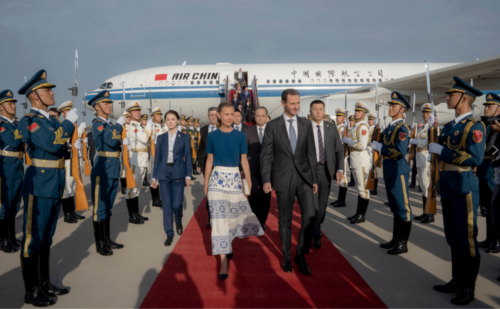Huawei’s latest smartphone defies U.S. export restrictions
Huawei's new Mate 60 Pro smartphone includes a high-performance processor that U.S. measures were supposed to preclude. But industry analysts say it will be difficult for China to continue innovating its way to making even more advanced chips.

Huawei last Tuesday launched online pre-order sales of its latest smartphone, the Mate 60 Pro, which contains advanced tech that some observers believe shows the Chinese telecommunications company has found ways around U.S. export controls. The phone later went on sale in the company’s brick-and-mortar stores across China on Sunday.
The smartphone’s Kirin 9000s chip is at the 7-nanometer (nm) process, TechInsights, a semiconductor research firm, confirmed on the weekend after a “teardown” of the phone conducted for Bloomberg. This means that Huawei succeeded in finding a way around U.S. policies that were meant to prevent Chinese firms from even developing less advanced, 14-nm processors (the lower the nm number, the more advanced the chip).
TechInsights said that the “difficulty of this achievement also shows the resilience of [China’s] chip technological ability,” which it called “a great geopolitical challenge to the countries who have sought to restrict its access to critical manufacturing technologies.”
The new chip was designed by Huawei’s in-house unit HiSilicon, and manufactured by Shanghai-based SMIC, both of which are on a U.S. trade blacklist.
A veiled signal to the U.S.?
In what may have been a veiled signal to American policymakers, the launch coincided with the visit to China of U.S. Secretary of Commerce Gina Raimondo. The Department of Commerce’s Bureau of Industry and Security has implemented some of the toughest American restrictions meant to hobble Huawei. Representatives from the Department of Commerce did not respond to requests for comment.
The new Mate 60 Pro represents a massive comeback for Huawei, which previously hadn’t released a 5G phone due to the U.S. restrictions. American sanctions have squeezed the company since it was first blacklisted in 2019; its share of the global phone handset market shrank from nearly 20% in 2020 to just 4% in 2022.
The new model is expected to sell well in China, where orders could exceed 12 million units over the next 12 months, one analyst told Chinese media outlet Yicai. After the phone first went on sale, Huawei increased production estimates to 15-17 million units, sources involved in the phone’s supply chain told Chinese media in recent days.
As of September 1, Huawei had already sold 800,000 units in a new record for the company, according to Chinese media. A Mate 60 Pro with 512 gigabytes of storage space sells for 6,999 yuan ($960) on Huawei’s VMALL online marketplace.
While the processors in Huawei’s new phone are not as advanced as those produced by Taiwanese manufacturer TSMC for companies like Apple, the development still represents an important technological leap in defiance of American efforts to restrict the company, said Paul Triolo, technology policy lead at Dentons Global Advisors ASG, a Washington-based consultancy.
A stopgap measure
But while SMIC is able to manufacture the Kirin 9000s for commercial use, it won’t be able to achieve the same kinds of production yields as it does for less advanced chips, Triolo said. It will also be difficult for Huawei to keep up with more advanced competitors, he added.
“With the cutting edge for manufacturing continuing to move out, it will be difficult for Huawei and SMIC to keep replicating this success,” he said. “Ultimately this is likely viewed by SMIC and Huawei as a stopgap until the domestic industry can come up with something resembling cutting-edge extreme ultraviolet (EUV) lithography.”
EUV lithography machines are used to “print” the world’s most advanced semiconductors. Highly complex, only Netherlands-based ASML has successfully commercialized EUV lithography. For China to develop its own EUV machines “is still some years off,” said Triolo.
Copenhagen Business School professor Douglas Fuller told The China Project that low yields of the new chipset show that China is still a long way from efficient mass production of advanced semiconductors.
“Industry rumors have the production yield at less than 10%, which is terrible,” he said. “The Chinese state is footing the large bill for this inefficient production, which is a good deal for Huawei but not a smart way to advance China’s indigenous fabrication technology.”
In semiconductor production, the yield is the fraction of the chips that make it through the manufacturing process with no defects.
The new Mate 60 Pro also includes upgrades to the camera, satellite connectivity capabilities, and a tougher, more fall-resistant touchscreen, according to a press release posted to Huawei’s Weibo account.
Update: The new phone also apparently uses a chip made by South Korean firm SK Hynix, which responded: “SK Hynix no longer does business with Huawei since the introduction of the U.S. restrictions against the company and with regard to the issue, we started an investigation to find out more details.”






